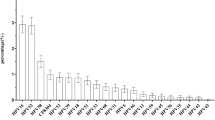Abstract
Human papilloma virus (HPV) causes cervical cancer in women and approximately 700 deaths have been reported annually in Sri Lanka due to this cancer. Despite, attempts have not been made to investigate the prevalence of HPV amongst Sri Lankan women with normal cytology. In this study, a polymerase chain reaction based assay was set up to detect HPV in both normal and abnormal cytology and the positive samples were then tested for the genotypes, HPV 16 and HPV 18 as they have been identified as the high-risk types associating with cervical cancer. Eighty-four (number = 84) clinical samples (age range 27–69) analyzed in this study indicated that the prevalence of HPV, regardless of cytological abnormalities was 15.5%, (n = 13, 95% class interval ± 7.7) while it was 100% (n = 3) for those with abnormal cytology. Association of HPV 16 and HPV 18 among the abnormal cytology was 0 and 50% (n = 1), respectively and further, the prevalence of HPV 16 and HPV 18 in women was found to be 3.6% (n = 3, 95% CI ± 4.0) and 2.4% (n = 2, 95% CI ± 3.3), respectively. Moreover, age wise prevalence analysis revealed women of the age of 35-years or more to have higher HPV prevalence. The prevalence of HPV among normal cytology is 12.3% (n = 10, 95% CI ± 7.2) which is similar to the rates in other regions of Asia (China 15.4%; India 10.43%). Finally, higher prevalence of HPV in women of the age of 35-years or more in Sri Lanka, especially with malignant types call for such age group to be screened for proper clinical intervention to be made in reducing the incident of cervical cancers. This is the first report of prevalence of HPV among women with normal cytology in Sri Lanka.

Similar content being viewed by others
References
Brule AJCVD, Pol R, Fransen DN, Schouls LM, Meijer CJLM, Snijders PJF. GP5+/6+ PCR followed by reverse line blot analysis enables rapid and high-throughput identification of human papillomavirus genotypes. J Clin Microbiol. 2002;40:779–87.
Chopra I, Roberts M. Tetracycline antibiotics: mode of action, applications molecular biology and epidemiology of bacterial resistance. Microbiol Mol Biol. 2001;65:232–60.
Cuzick J, Arbyn M, Sankaranarayanan R, Tsu V, Ronco G, Mayrand MH, Dillner J, Meijer CJLM. Overview of human papillomavirus-based and other novel options for cervical cancer screening in developed and developing countries. Vaccine. 2008;26:29–41.
Doorbar J. The papillomavirus life cycle. J Clin Virol. 2005;32:7–15.
Doorbar J. Molecular biology of human papillomavirus infection and cervical cancer. Clin Sci. 2006;541:525–41.
Doorn LJV, Kleter B, Quint WGV. Molecular detection and genotyping of human papillomavirus. Rev Mol Diagn. 2001;1:394–402.
Dunne EF, Unger ER, Sternberg M, Mcquillan G, Swan DC, Patel SS, Markowitz LE. Prevalence of HPV infection among females in the United States. JAMA. 2007;297:813–9.
Freitas TP, Carmo BBD, Paula FDF, Rodrigues LF, Fernandes AP, Fernandes PA. Molecular detection of HPV 16 and 18 in cervical samples of patients from belo horizonte, minas gerais, Brazil. Rev Inst Trop. 2007;49:297–301.
Gheit T, Landi S, Gemignani F, Snijders PJF, Vaccarella S, Franceschi S, Canzian F, Tommasino M. Development of a sensitive and specific assay combining multiplex PCR and DNA microarray primer extension to detect high-risk mucosal human papillomavirus types. J Clin Microbiol. 2006;44:2025–31.
Husman AMDR, Walboomers JMM, Brule AJCVD, Meijer CJLM, Sniders PJF. The use of general primers Gp5 and Gp6 elongated at their 3′ ends with adjacent highly conserved sequences improves human papillomavirus detection by PCR. J Gen Virol. 1995;76:1057–62.
Karunaratne K, Ihalagama H, Rohitha S, Molijn A, Gopala K, Schmidt JE, Chen J, Datta S, Mehta S. Human papillomavirus prevalence and type-distribution in women with cervical lesions: a cross-sectional study in Sri Lanka. BMC Cancer. 2014;14:1–6.
Kuo YB, Li YS, Chan EC. Rapid identification of HPV 16 and 18 by multiplex nested PCR-immunochromatographic test. J Virol Methods. 2015;212:8–11.
Li Z, Liu F, Cheng S, Shi L, Yan Z, Yang J, Shi L, Yao Y, Ma Y. Prevalence of HPV infection among 28,457 Chinese women in Yunnan Province, southwest China. Nature. 2016. https://doi.org/10.1038/srep21039.
Molijn A, Kleter B, Quint W, Doorn LDV. Molecular diagnosis of human papillomavirus (HPV) Infections. J Clin Virol. 2005;32:43–51.
Munoz M, Camargo M, Soto-De Leon SC, Rojas A, Sanchez R, Jaimes C, Perez-Prados A, Patarroyo ME, Patarroyo MA. The diagnostic performance of classical molecular tests used for detecting human papillomavirus. J Virol Methods. 2012;185:32–8.
Nour NM. Cervical cancer a preventable death. Rev Obstet Gynecol. 2009;2:240–4.
Nunes JDC, Vidal FCB, Ferraro CTL, Chein MBC, Brito LMO, Monteiro SCM. Molecular detection of human papillomavirus in Brazilian women with cervical intraepithelial neoplasia in a northeast Brazilian city. Genet Mol Biol. 2014;13:9077–85.
Piana A, Sotgiu G, Castiglia P, Pischedda S, Dettori M, Cocuzza C, Muresu E, Maida A. Molecular methods for the detection of human papillomavirus infection: new insights into their role in diagnostics and epidemiological surveillance. Ital J Public Health. 2009;6:164–71.
Samarawickrema NA, Tabrizi SN, Hewavisenthi J, Leong T, Garland SM. Distribution of human papillomavirus genotypes in archival cervical tissue from women with cervical cancer in urban Sri Lanka. Int J Gynecol Obstet. 2011;115:180–2.
Schiffman M, Castle PE. HPV epidemiology and public health. Arch Pathol Lab Med. 2003;127:930–4.
Villiers EMD, Fauquet C, Broker TR, Bernard HV, Hausen HZ. Classification of papillomaviruses. J Virol. 2004;324:17–27.
Wang HY, Lee D, Park S, Kim G, Sunghynm K, Han L, Yubo R, Li Y, Park KH, Lee H. Diagnostic performance of HPV E6/E7 mRNA and HPV DNA assays for the detection and screening of oncogenic human papillomavirus infection among woman with cervical lesions in China. Asian Pac J Cancer Prev. 2015;16:7633–40.
Acknowledgements
This work was supported by Durdans Hospital (Pvt) Ltd and Biotechnology funds, Department of Chemistry, University of Colombo, Sri Lanka.
Author information
Authors and Affiliations
Corresponding author
Rights and permissions
About this article
Cite this article
Shanaka, K.A.S.N., Wilathgamuwa, S., Gunawardene, Y.I.N.S. et al. Prevalence of human papilloma virus and their high-risk genotypes in Sri Lankan women. VirusDis. 29, 27–31 (2018). https://doi.org/10.1007/s13337-018-0419-7
Received:
Accepted:
Published:
Issue Date:
DOI: https://doi.org/10.1007/s13337-018-0419-7




